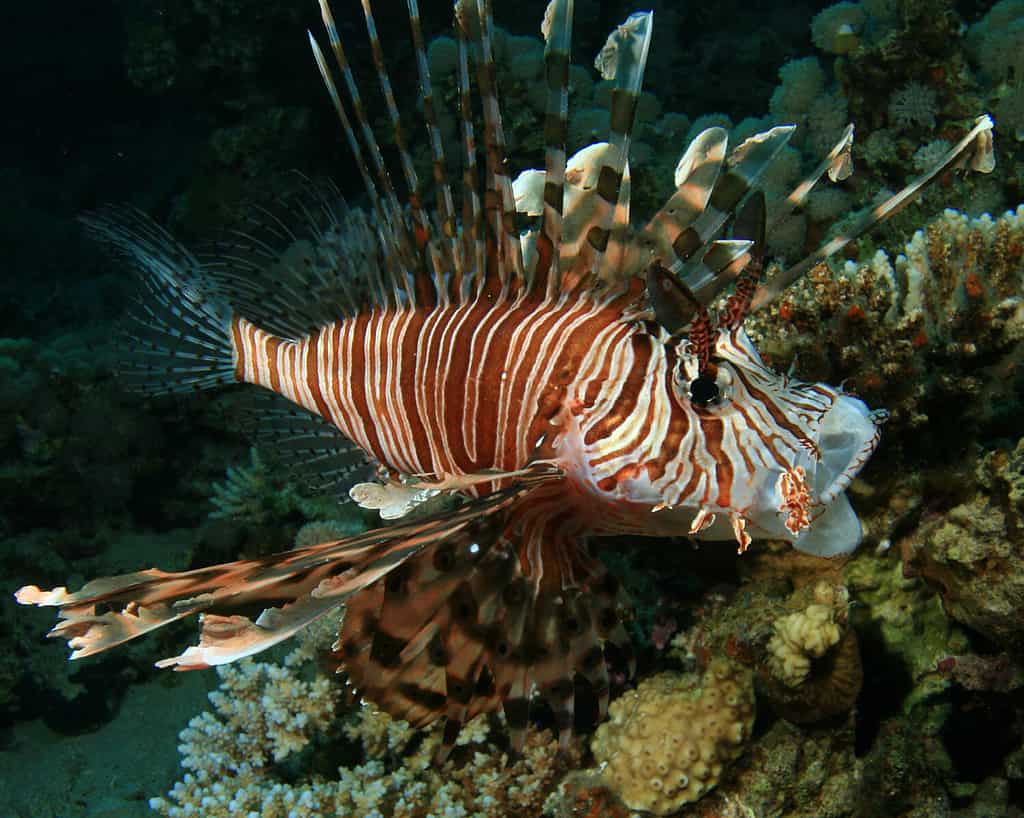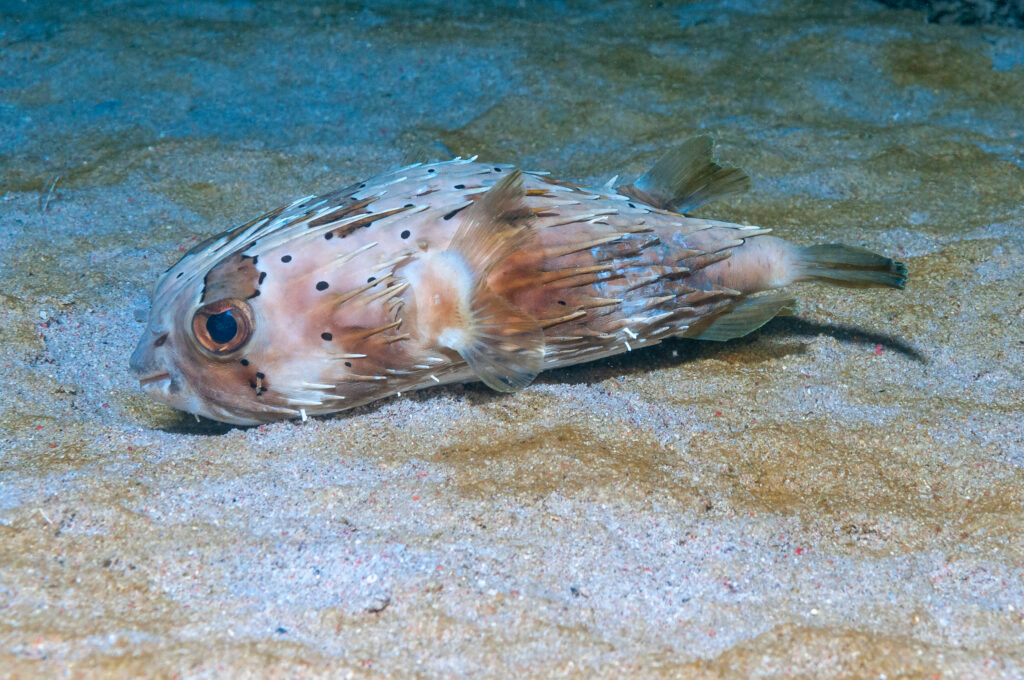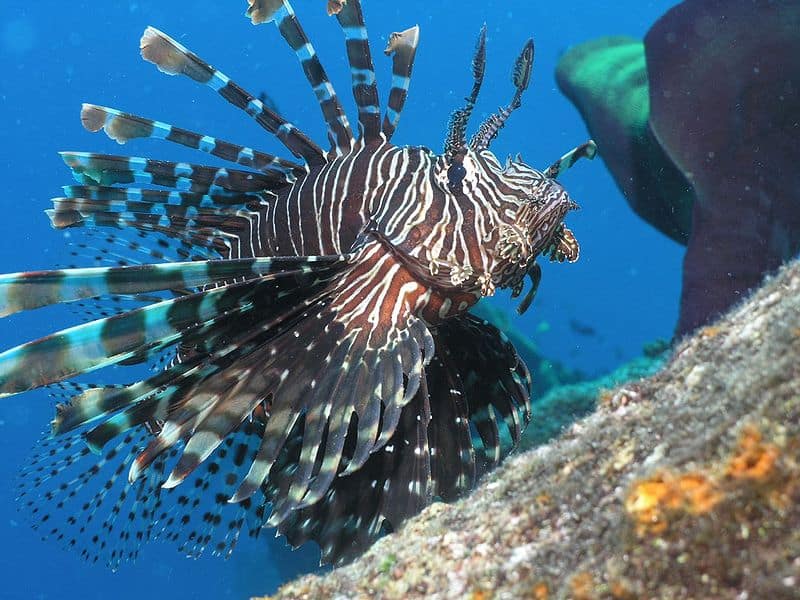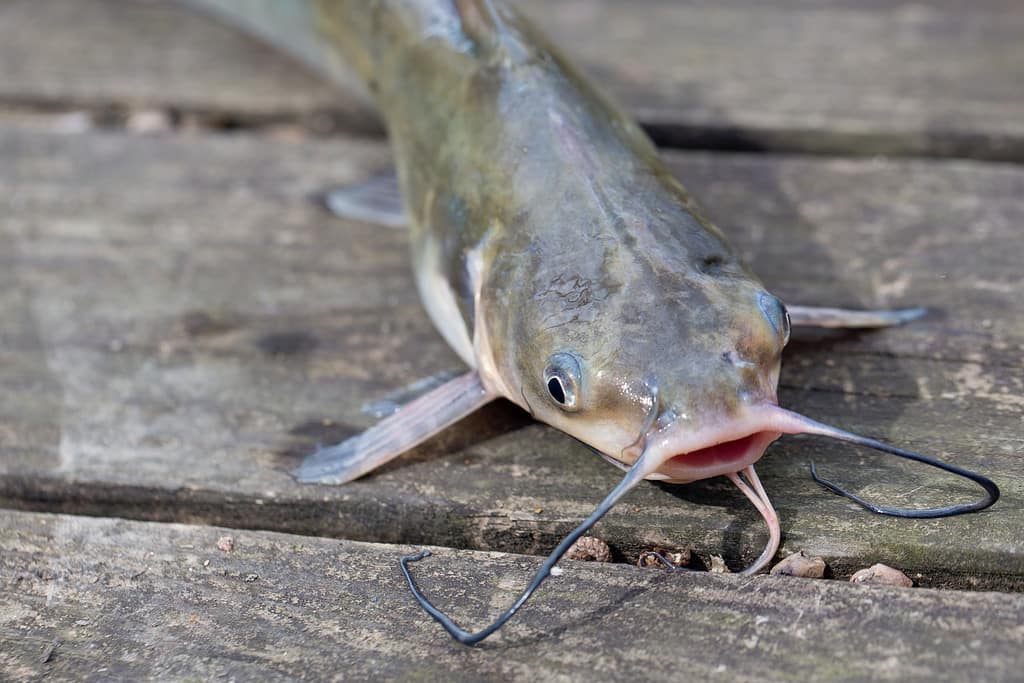
The red lionfish is an invasive species in Florida.
©Greens and Blues/Shutterstock.com
Fish that have spikes use the sharp points on their spikes to keep predators from eating them. Some fish, like the catfish, can lock their spikes in an outward position, while other fish can deliver venom through their spines. Fish that have spikes rarely use the spikes as tools when they hunt.
The bony spines are called rays. The rays are not part of the skeletal makeup of the fish. Fish spikes can be hard, like bone, or they can be flexible. Spikes have sharp points on the end.
When swimming in waters that have fish like lionfish or stonefish in them, you should wear rubber swim shoes to prevent stepping on the venomous spikes. When swimming close to these fish, do not try to touch them.
1. Porcupinefish, Diodon hystrix

Porcupinefish have 20 spikes in a row between their dorsal fin and their snout.
©Jesus Cobaleda/Shutterstock.com
Among the fish that have spikes, the porcupine fish is the most obvious one that comes to mind. The porcupine fish is non-venomous; however, those spines are still weapons they can use to deter predators. The lionfish have 20 spikes along their body, from their snout to their dorsal fin.
Porcupine fish belong to the pufferfish family. The porcupine fish can gulp in water and puff itself up to make it larger. When they puff themselves up, their spines stick out, making it hard for a predator to get the fish in their mouth.
You will find these fish on coral reefs in tropical and subtropical seas worldwide. They feed on sea urchins, gastropods, and crustaceans like clams and the occasional snail. Do not try to touch a porcupinefish.
An adult porcupine fish has few predators; however, sharks and orcas will attack them if the opportunity presents itself. Predators of juvenile porcupine fish include dolphins and tuna. These fish do not have venomous spikes; however, like the other pufferfish, they are toxic if not prepared properly. They are an exotic delicacy.
2. Stonefish; Synanceia
Stonefish, especially the Reef Stonefish, are the most venomous fish in the world. They deliver their venom through the spines running along their backs. Most fish can only survive a few minutes out of water; the stonefish, however, can survive for up to 24 hours out of water.
This species of fish made the list of the three fish that have spikes because they can use their spikes to inject venom into a predator. The only animals that dare to mess with these spiny fish are sharks, large, venomous sea snakes, and rays. The stonefish’s venom is strong enough to paralyze or kill most animals.
Stonefish are edible, but the venom at the bottom of the dorsal fin must be removed. Then, the fish meat is sweet and flaky, and even the fish’s skin is edible. They are cooked in soups and stews and served raw in sushi dishes.
3. Lionfish

Lionfish use their eighteen poisonous spikes as a form of defense.
©Sebastian Wallroth / Creative Commons – License
The list of three spiked fish had to include the impressive lionfish. A lionfish’s swimming speed is slow. They move slowly through the water, and their colors and shapes make them noticeable. Their spikes and spines allow them to deter any predator that thinks of making them into a meal.
These fish are native to the South Pacific and Indian Oceans; however, they are thriving in other waters as invasive species. Lionfish are in the waters around Florida and New York. They have few natural predators in those waters. The presence of an invasive species disrupts the natural ecosystem.
With all those spikes, you would think that the lionfish would not have to worry about predators. They do not have many predators; however, some marine animals that eat lionfish include sharks, cornetfish, large eels, and scorpionfish.
Lionfish are dangerous animals. It is rare for a human to die after being stung by one of these fish; however, death will occur without proper treatment. The sting from a lionfish can produce painful symptoms lasting 8 to 30 days.
What To Do If Stung By a Lionfish
If you are stung by a lionfish, do the following:
- First, wear a glove to protect your hands and fingers. Use tweezers to remove any spikes that are protruding from your skin. When you are removing the spikes, handle them with care so you do not squeeze the venom gland located in the spike. Squeezing the venom gland will release more venom into your system.
- Second, use warm water and a mild soap to carefully wash the area.
- Third, soak the affected area in hot water, not hot enough to scald you. If you were stung on the arm, leg, or back, stand in a hot shower, letting the water run over the affected area for up to 20 minutes.
- Fourth, call your doctor and see if your tetanus shots are up to date. If they are not, go get a tetanus shot.
- Take over-the-counter pain medications to ease the pain.
Seek emergency care when:
- You have severe muscle cramps after being stung.
- Once stung, you experience faintness or dizziness.
- You experience severe swelling.
- If you run a fever after being stung,
- If you think there may be a spike still inside your body,
- If you feel excruciating pain,
- if reddish streaks appear in the vicinity or if the area turns red.
- If the sting becomes infected or has signs of pus,
More fish that have spikes or spines
The majority of fish have spines and spikes. You will discover that fish have sharp points, or spines, on their fins to lift and use to elude a predator. This holds for both species of freshwater and saltwater fish.
On a common fish, such as a sunfish, place the fin down to prevent getting entangled in the spikes. Some fish spikes inflict a little pain, but other fish spikes, like the ones on a gafftopsail catfish, inflict a lot of pain. The spikes on the catfish have barbs on the end of them, like tiny fishhooks, and when the spikes are stuck into your skin, the barbs keep them from easily being removed.
| Fish in Freshwater with Spikes | Saltwater Fish That Have Spikes |
| Spikes adorn the fins of blue-gill perch. | Stargazers |
| Blue-gill perch have spines on their fins. | Spiny-finned fish |
| Three-spined stickleback | Scorpionfish |
| Crappie | Sea Urchin |
| Bass | Queenfish |
| Needlefish | |
| Gafftopsail catfish | |
| Leatherjacket |
What To Do If Stuck By A Non-Venomous Fish Spike

Channel catfish have whiskers around their mouths, giving them the “catfish” name.
©Jenniveve84/iStock / Getty Images Plus via Getty Images
Getting poked by fish that have spikes is painful. If the fish is not venomous like the lionfish, the injury will be more painful than dangerous; however, if you do not treat it properly, it can become infected. When a fish spike injures you, you treat the wound as a puncture.
- First, clean the wound using soap and warm water.
- Second, encourage the puncture wound to bleed.
- Third, apply a triple antibiotic ointment and a light bandage for a few hours.
- If the wound is bleeding and does not stop in a few minutes, you should apply pressure. Press a clean, dry cloth against the wound and hold the cloth firmly in place for a few minutes to stop the bleeding.
When to See A Doctor
- If you run a fever,
- If you experience severe pain at the puncture site,
- If there is severe swelling at the site,
- If the area becomes inflamed or has red streaks coming from it,
- If the wound becomes infected,
- If the wound turns dark in color or has a foul odor,
Summary of 3 Fish That Have Spikes and What They Use Them For
| Fish Species | Number of Spikes | Venomous Spines | How they use their spikes | |
| 1 | Porcupinefish | 20 | No | As a deterrent to predators. |
| 2 | Stonefish | 13 | Yes | To inject their venom into predators. |
| 3 | Lionfish | 18 | Yes | To defend themselves against predators. |
The photo featured at the top of this post is © Vlad61/Shutterstock.com
Thank you for reading! Have some feedback for us? Contact the AZ Animals editorial team.






